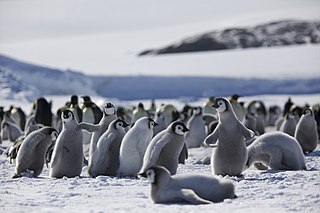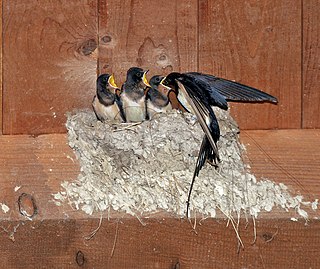
Behavioral ecology, also spelled behavioural ecology, is the study of the evolutionary basis for animal behavior due to ecological pressures. Behavioral ecology emerged from ethology after Niko Tinbergen outlined four questions to address when studying animal behaviors: What are the proximate causes, ontogeny, survival value, and phylogeny of a behavior?

The tree swallow is a migratory bird of the family Hirundinidae. Found in the Americas, the tree swallow was first described in 1807 by French ornithologist Louis Vieillot as Hirundo bicolor. It has since been moved to its current genus, Tachycineta, within which its phylogenetic placement is debated. The tree swallow has glossy blue-green upperparts, with the exception of the blackish wings and tail, and white underparts. The bill is black, the eyes dark brown, and the legs and feet pale brown. The female is generally duller than the male, and the first-year female has mostly brown upperparts, with some blue feathers. Juveniles have brown upperparts, and grey-brown-washed breasts. The tree swallow breeds in the US and Canada. It winters along southern US coasts south, along the Gulf Coast, to Panama and the northwestern coast of South America, and in the West Indies.

Helpers at the nest is a term used in behavioural ecology and evolutionary biology to describe a social structure in which juveniles and sexually mature adolescents of either one or both sexes remain in association with their parents and help them raise subsequent broods or litters, instead of dispersing and beginning to reproduce themselves. This phenomenon was first studied in birds where it occurs most frequently, but it is also known in animals from many different groups including mammals and insects. It is a simple form of co-operative breeding. The effects of helpers usually amount to a net benefit, however, benefits are not uniformly distributed by all helpers nor across all species that exhibit this behaviour. There are multiple proposed explanations for the behaviour, but its variability and broad taxonomic occurrences result in simultaneously plausible theories.

The blue-footed booby is a marine bird native to subtropical and tropical regions of the eastern Pacific Ocean. It is one of six species of the genus Sula – known as boobies. It is easily recognizable by its distinctive bright blue feet, which is a sexually selected trait and a product of their diet. Males display their feet in an elaborate mating ritual by lifting them up and down while strutting before the female. The female is slightly larger than the male and can measure up to 90 cm (35 in) long with a wingspan up to 1.5 m (5 ft).
Parent–offspring conflict (POC) is an expression coined in 1974 by Robert Trivers. It is used to describe the evolutionary conflict arising from differences in optimal parental investment (PI) in an offspring from the standpoint of the parent and the offspring. PI is any investment by the parent in an individual offspring that decreases the parent's ability to invest in other offspring, while the selected offspring's chance of surviving increases.

Alloparenting is a term used to classify any form of parental care provided by an individual towards young that are not its own direct offspring. These are often referred to as "non-descendant" young, even though grandchildren can be among them. Among humans, alloparenting is often performed by a child's grandparents and older siblings. Individuals providing this care are referred to using the neutral term of alloparent.

The Nazca booby is a large seabird of the booby family, Sulidae, native to the eastern Pacific. First described by Walter Rothschild in 1902, it was long considered a subspecies of the masked booby until recognised as distinct genetically and behaviorally in 2002. It has a typical sulid body shape, with a long pointed orange-yellow bill, long neck, aerodynamic body, long slender wings and pointed tail. The adult is bright white with black and white wings, a black tail and a dark face mask.
Cross-fostering is a technique used in animal husbandry, animal science, genetic and nature versus nurture studies, and conservation, whereby offspring are removed from their biological parents at birth and raised by surrogates, typically of a different species, hence 'cross.' This can also occasionally occur in nature.

In animals, infanticide involves the intentional killing of young offspring by a mature animal of the same species. Animal infanticide is studied in zoology, specifically in the field of ethology. Ovicide is the analogous destruction of eggs. The practice has been observed in many species throughout the animal kingdom, especially primates but including microscopic rotifers, insects, fish, amphibians, birds and mammals. Infanticide can be practiced by both males and females.

Parental care is a behavioural and evolutionary strategy adopted by some animals, involving a parental investment being made to the evolutionary fitness of offspring. Patterns of parental care are widespread and highly diverse across the animal kingdom. There is great variation in different animal groups in terms of how parents care for offspring, and the amount of resources invested by parents. For example, there may be considerable variation in the amount of care invested by each sex, where females may invest more in some species, males invest more in others, or investment may be shared equally. Numerous hypotheses have been proposed to describe this variation and patterns in parental care that exist between the sexes, as well as among species.
Mate desertion occurs when one or both parents abandon their current offspring, and thereby reduce or stop providing parental care. Often, by deserting, a parent attempts to increase breeding opportunities by seeking out another mate. This form of mating strategy behavior is exhibited in insects, birds and mammals. Typically, males are more likely to desert, but both males and females have been observed to practice mate desertion.

Egg tossing or egg destruction is a behavior observed in some species of birds where one individual removes an egg from the communal nest. This is related to infanticide, where parents kill their own or other's offspring. Egg tossing is observed in avian species, most commonly females, who are involved with cooperative breeding or brood parasitism. Among colonial non-co-nesting birds, egg-tossing is observed to be performed by an individual of the same species, and, in the case of brood parasites, this behavior is done by either the same or different species. The behavior of egg tossing offers its advantages and disadvantages to both the actor and recipient.

The term seabird is used for many families of birds in several orders that spend the majority of their lives at sea. Seabirds make up some, if not all, of the families in the following orders: Procellariiformes, Sphenisciformes, Pelecaniformes, and Charadriiformes. Many seabirds remain at sea for several consecutive years at a time, without ever seeing land. Breeding is the central purpose for seabirds to visit land. The breeding period is usually extremely protracted in many seabirds and may last over a year in some of the larger albatrosses; this is in stark contrast with passerine birds. Seabirds nest in single or mixed-species colonies of varying densities, mainly on offshore islands devoid of terrestrial predators. However, seabirds exhibit many unusual breeding behaviors during all stages of the reproductive cycle that are not extensively reported outside of the primary scientific literature.

Within the insect order Hymenoptera, the Halictinae are the largest, most diverse, and most recently diverged of the four halictid subfamilies. They comprise over 2400 bee species belonging to the five taxonomic tribes Augochlorini, Thrinchostomini, Caenohalictini, Sphecodini, and Halictini, which some entomologists alternatively organize into the two tribes Augochlorini and Halictini.
Filial cannibalism occurs when an adult individual of a species consumes all or part of the young of its own species or immediate offspring. Filial cannibalism occurs in many species ranging from mammals to insects, and is especially prevalent in various types of fish species with males that engage in egg guardianship. The exact evolutionary purpose of the practice in those species is unclear and debated among zoologists, though there is consensus that it may have, or may have had at some point in species' evolutionary history, certain evolutionary and ecological implications.

Begging in animals is when an animal solicits being given resources by another animal. This is usually a young animal soliciting food from their parents, brood hosts or other adults. However, the resource is sometimes non-food related or may be solicited by adult animals. Begging behavior is most widely studied in birds, however, mammals, amphibians, and invertebrates perform begging displays. Generally in food solicitation, begging behavior is instinctive, although in some instances it is learned.
Animals, including siblings, compete for resources such as food, territory, and potential mating partners. In animal sibling rivalry, individuals compete for parental care or limited resources, which can sometimes result in siblicide, the killing of siblings. Sibling rivalry occurs in many different forms. Siblings may compete for resources in a prenatal and/or post-birth environment. The degree of rivalry varies, ranging from a low level of violence in non-aggressive to the killing of kin in siblicide.

Parental care refers to the level of investment provided by the mother and the father to ensure development and survival of their offspring. In most birds, parents invest profoundly in their offspring as a mutual effort, making a majority of them socially monogamous for the duration of the breeding season. This happens regardless of whether there is a paternal uncertainty.
Vertebrate maternal behavior is a form of parental care that is specifically given to young animals by their mother in order to ensure the survival of the young. Parental care is a form of altruism, which means that the behaviors involved often require a sacrifice that could put their own survival at risk. This encompasses behaviors that aid in the evolutionary success of the offspring and parental investment, which is a measure of expenditure exerted by the parent in an attempt to provide evolutionary benefits to the offspring. Therefore, it is a measure of the benefits versus costs of engaging in the parental behaviors. Behaviors commonly exhibited by the maternal parent include feeding, either by lactating or gathering food, grooming young, and keeping the young warm. Another important aspect of parental care is whether the care is provided to the offspring by each parent in a relatively equal manner, or whether it is provided predominantly or entirely by one parent. There are several species that exhibit biparental care, where behaviors and/or investment in the offspring is divided equally amongst the parents. This parenting strategy is common in birds. However, even in species who exhibit biparental care, the maternal role is essential since the females are responsible for the incubation and/or delivery of the young.

Brood reduction occurs when the number of nestlings in a birds brood is reduced, usually because there is a limited amount of resources available. It can occur directly via infanticide, or indirectly via competition over resources between siblings. Avian parents often produce more offspring than they can care for, resulting in the death of some of the nestlings. Brood reduction was originally described by David Lack in his brood-reduction hypothesis to explain the existence of hatching asynchrony in many bird species.










































